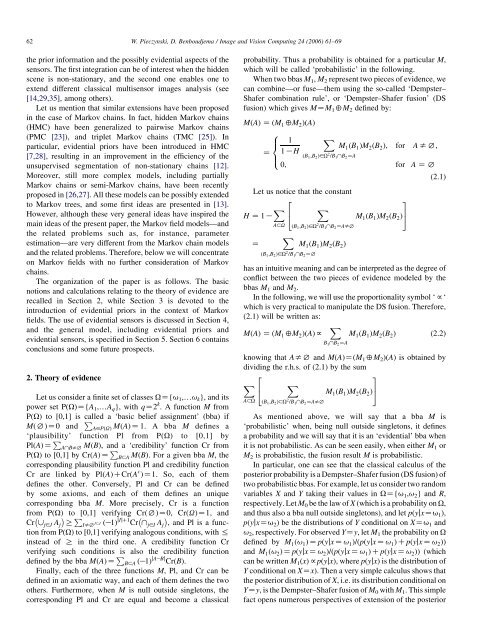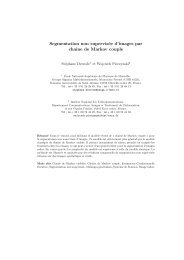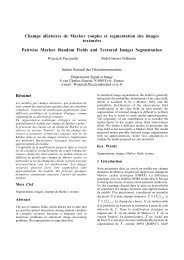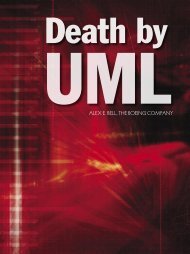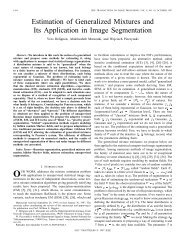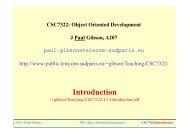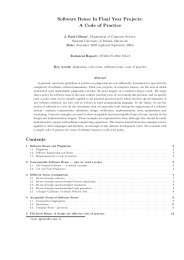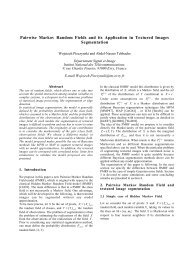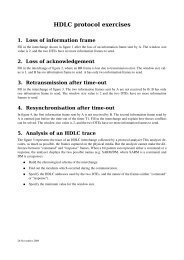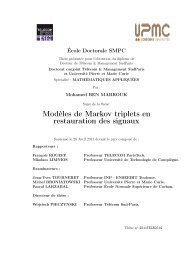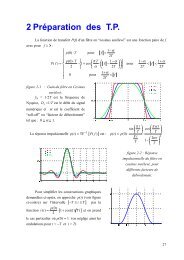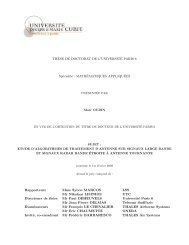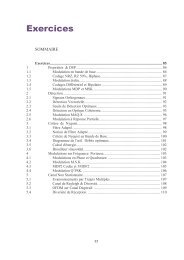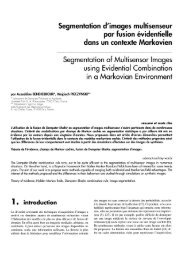Multisensor triplet Markov fields and theory of evidence
Multisensor triplet Markov fields and theory of evidence
Multisensor triplet Markov fields and theory of evidence
Create successful ePaper yourself
Turn your PDF publications into a flip-book with our unique Google optimized e-Paper software.
62<br />
W. Pieczynski, D. Benboudjema / Image <strong>and</strong> Vision Computing 24 (2006) 61–69<br />
the prior information <strong>and</strong> the possibly evidential aspects <strong>of</strong> the<br />
sensors. The first integration can be <strong>of</strong> interest when the hidden<br />
scene is non-stationary, <strong>and</strong> the second one enables one to<br />
extend different classical multisensor images analysis (see<br />
[14,29,35], among others).<br />
Let us mention that similar extensions have been proposed<br />
in the case <strong>of</strong> <strong>Markov</strong> chains. In fact, hidden <strong>Markov</strong> chains<br />
(HMC) have been generalized to pairwise <strong>Markov</strong> chains<br />
(PMC [23]), <strong>and</strong> <strong>triplet</strong> <strong>Markov</strong> chains (TMC [25]). In<br />
particular, evidential priors have been introduced in HMC<br />
[7,28], resulting in an improvement in the efficiency <strong>of</strong> the<br />
unsupervised segmentation <strong>of</strong> non-stationary chains [12].<br />
Moreover, still more complex models, including partially<br />
<strong>Markov</strong> chains or semi-<strong>Markov</strong> chains, have been recently<br />
proposed in [26,27]. All these models can be possibly extended<br />
to <strong>Markov</strong> trees, <strong>and</strong> some first ideas are presented in [13].<br />
However, although these very general ideas have inspired the<br />
main ideas <strong>of</strong> the present paper, the <strong>Markov</strong> field models—<strong>and</strong><br />
the related problems such as, for instance, parameter<br />
estimation—are very different from the <strong>Markov</strong> chain models<br />
<strong>and</strong> the related problems. Therefore, below we will concentrate<br />
on <strong>Markov</strong> <strong>fields</strong> with no further consideration <strong>of</strong> <strong>Markov</strong><br />
chains.<br />
The organization <strong>of</strong> the paper is as follows. The basic<br />
notions <strong>and</strong> calculations relating to the <strong>theory</strong> <strong>of</strong> <strong>evidence</strong> are<br />
recalled in Section 2, while Section 3 is devoted to the<br />
introduction <strong>of</strong> evidential priors in the context <strong>of</strong> <strong>Markov</strong><br />
<strong>fields</strong>. The use <strong>of</strong> evidential sensors is discussed in Section 4,<br />
<strong>and</strong> the general model, including evidential priors <strong>and</strong><br />
evidential sensors, is specified in Section 5. Section 6 contains<br />
conclusions <strong>and</strong> some future prospects.<br />
2. Theory <strong>of</strong> <strong>evidence</strong><br />
Let us consider a finite set <strong>of</strong> classes UZ{u 1 ,.u k }, <strong>and</strong> its<br />
power set P(U)Z{A 1 ,.A q }, with qZ2 k . A function M from<br />
P(U) to [0,1] is called a ‘basic belief assignment’ (bba) if<br />
M(:)Z0 <strong>and</strong> P A2PðUÞ MðAÞZ1. A bba M defines a<br />
‘plausibility’ function Pl from P(U) to [0,1] by<br />
PlðAÞZ P AhBs: MðBÞ, <strong>and</strong> a ‘credibility’ function Cr from<br />
P(U) to [0,1] by CrðAÞZ P B3A MðBÞ. For a given bba M, the<br />
corresponding plausibility function Pl <strong>and</strong> credibility function<br />
Cr are linked by Pl(A)CCr(A c )Z1. So, each <strong>of</strong> them<br />
defines the other. Conversely, Pl <strong>and</strong> Cr can be defined<br />
by some axioms, <strong>and</strong> each <strong>of</strong> them defines an unique<br />
corresponding bba M. More precisely, Cr is a function<br />
from P(U) to [0,1] verifying Cr(:)Z0, Cr(U)Z1, <strong>and</strong><br />
Cr g j2J A j<br />
<br />
R<br />
PIs: I3J ðK1ÞjIjC1 Cr h j2I A j<br />
<br />
, <strong>and</strong> Pl is a function<br />
from P(U) to [0,1] verifying analogous conditions, with %<br />
instead <strong>of</strong> R in the third one. A credibility function Cr<br />
verifying such conditions is also the credibility function<br />
defined by the bba MðAÞZ P B3A ðK1Þ jAKBj CrðBÞ.<br />
Finally, each <strong>of</strong> the three functions M, Pl, <strong>and</strong> Cr can be<br />
defined in an axiomatic way, <strong>and</strong> each <strong>of</strong> them defines the two<br />
others. Furthermore, when M is null outside singletons, the<br />
corresponding Pl <strong>and</strong> Cr are equal <strong>and</strong> become a classical<br />
probability. Thus a probability is obtained for a particular M,<br />
which will be called ‘probabilistic’ in the following.<br />
When two bbas M 1 , M 2 represent two pieces <strong>of</strong> <strong>evidence</strong>, we<br />
can combine—or fuse—them using the so-called ‘Dempster–<br />
Shafer combination rule’, or ‘Dempster–Shafer fusion’ (DS<br />
fusion) which gives MZM 1 4M 2 defined by:<br />
MðAÞ Z ðM 1 4M 2 ÞðAÞ<br />
8<br />
1 X<br />
><<br />
M<br />
Z 1KH<br />
1 ðB 1 ÞM 2 ðB 2 Þ; for As:;<br />
ðB 1 ;B 2 Þ2U 2 =B 1 hB 2 ZA<br />
>:<br />
0; for A Z :<br />
(2.1)<br />
Let us notice that the constant<br />
2<br />
3<br />
H Z 1K X X<br />
4<br />
A3U<br />
M 1 ðB 1 ÞM 2 ðB 2 Þ5<br />
Z<br />
X<br />
ðB 1 ;B 2 Þ2U 2 =B 1 hB 2 Z:<br />
ðB 1 ;B 2 Þ2U 2 =B 1 hB 2 ZAs:<br />
M 1 ðB 1 ÞM 2 ðB 2 Þ<br />
has an intuitive meaning <strong>and</strong> can be interpreted as the degree <strong>of</strong><br />
conflict between the two pieces <strong>of</strong> <strong>evidence</strong> modeled by the<br />
bbas M 1 <strong>and</strong> M 2 .<br />
In the following, we will use the proportionality symbol ‘f‘<br />
which is very practical to manipulate the DS fusion. Therefore,<br />
(2.1) will be written as:<br />
MðAÞ Z ðM 1 4M 2 ÞðAÞf<br />
X<br />
M 1 ðB 1 ÞM 2 ðB 2 Þ (2.2)<br />
B 1 hB 2 ZA<br />
knowing that As: <strong>and</strong> M(A)Z(M 1 4M 2 )(A) is obtained by<br />
dividing the r.h.s. <strong>of</strong> (2.1) by the sum<br />
2<br />
3<br />
X<br />
4<br />
X<br />
M 1 ðB 1 ÞM 2 ðB 2 Þ5<br />
A3U<br />
ðB 1 ;B 2 Þ3U 2 =B 1 hB 2 ZAs:<br />
As mentioned above, we will say that a bba M is<br />
‘probabilistic’ when, being null outside singletons, it defines<br />
a probability <strong>and</strong> we will say that it is an ‘evidential’ bba when<br />
it is not probabilistic. As can be seen easily, when either M 1 or<br />
M 2 is probabilistic, the fusion result M is probabilistic.<br />
In particular, one can see that the classical calculus <strong>of</strong> the<br />
posterior probability is a Dempster–Shafer fusion (DS fusion) <strong>of</strong><br />
two probabilistic bbas. For example, let us consider two r<strong>and</strong>om<br />
variables X <strong>and</strong> Y taking their values in UZ{u 1 ,u 2 } <strong>and</strong> R,<br />
respectively. Let M 0 be the law <strong>of</strong> X (which is a probability on U,<br />
<strong>and</strong> thus also a bba null outside singletons), <strong>and</strong> let p(yjxZu 1 ),<br />
p(yjxZu 2 ) be the distributions <strong>of</strong> Y conditional on XZu 1 <strong>and</strong><br />
u 2 , respectively. For observed YZy, let M 1 the probability on U<br />
defined by M 1 ðu 1 ÞZpðyjxZu 1 Þ=ðpðyjxZu 1 ÞCpðyjxZu 2 ÞÞ<br />
<strong>and</strong> M 1 ðu 2 ÞZpðyjxZu 2 Þ=ðpðyjxZu 1 ÞCpðyjxZu 2 ÞÞ (which<br />
can be written M 1 (x)fp(yjx), where p(yjx) is the distribution <strong>of</strong><br />
Y conditional on XZx). Then a very simple calculus shows that<br />
the posterior distribution <strong>of</strong> X, i.e. its distribution conditional on<br />
YZy, is the Dempster–Shafer fusion <strong>of</strong> M 0 with M 1 . This simple<br />
fact opens numerous perspectives <strong>of</strong> extension <strong>of</strong> the posterior


